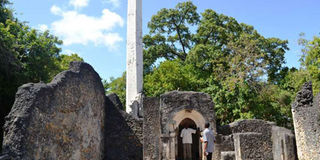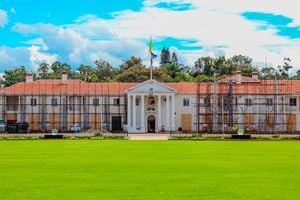Mnarani Ruins an alluring gem that harbours ancient secrets

Community tour guide Thomas Chai (left) at the Great Mosque in the Mnarani Ruins, Kilifi County. PHOTO | KAZUNGU SAMUEL | NATION MEDIA GROUP
What you need to know:
- The ruins are at the top of 107 steps you must climb to get a spectacular view. Mnarani Ruins are under the National Museums of Kenya.
- Community tour guide Thomas Chai said during my visit that low water supply and frequent attacks from the Galla people caused the Arabs to flee and settle in other Coastal towns, which were safe and had good water supply.
- Mnarani Ruins has a clean compound and is a perfect spot for picnics and for nature lovers to connect with the past. Clear pathways entice you to take a walk through history as you make a trip around the ruins.
Although it is a sleepy village near Kilifi Town, Mnarani harbours a rich historical site — the Mnarani Ruins.
It is a beauty and a great place to visit.
The ruins overlook Kilifi Creek from the southern side, 200 metres from the Mombasa-Malindi highway.
The ruins are at the top of 107 steps you must climb to get a spectacular view. Mnarani Ruins are under the National Museums of Kenya.
Chirping birds and the sound of rattling leaves blowing in the breeze from the sea set the ambience.
A glance into Mnarani Ruins reveals an ancient life. Mnarani is a Swahili word that means the “tower place”.
The history of these ruins dates back to the 13th century when Omani Arabs came to the East African Coast for trade. Their businesses flourished and they built their residence at Mnarani.
Community tour guide Thomas Chai said during my visit that low water supply and frequent attacks from the Galla people caused the Arabs to flee and settle in other Coastal towns, which were safe and had good water supply.
Mnarani has two mosques and tombs — an indication of early life.
The foundations of the great and smaller mosque, which are located in the eastern tower, are still intact. The mosques have also served modern generations.
The mosque comprises six sections: a well where water was fetched and stored in a tank to be used before prayers, a baraza where sandals were placed before entering the mosque, a worship area for women and men, an imams’ changing room and a pulpit, which is known as "kibla" by Muslims.
Mnarani Ruins has a clean compound and is a perfect spot for picnics and for nature lovers to connect with the past. Clear pathways entice you to take a walk through history as you make a trip around the ruins.
A hiking expedition is also available at the slaves tunnel.
A lover of natural beauty easily catches a view of the Mnarani Creek waters dotted with fishermen’s dhows, tourist boats and its beautiful green mangrove forest perched on the sandy beaches.
Mnarani Ruins is a place one can visit as an individual, a couple or a family to bond with nature.




